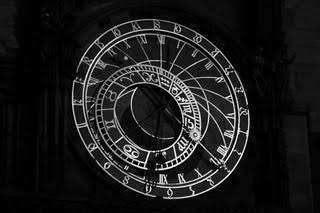
Time itself will end if this clock ever stops–evil and black magic lurk in the shadows of The Astronomical Clock on the Old Town Square of Prague. (photo by Joseph O’Neill, 2016)
Time is a mysterious, ever-flowing stream that seems to pool and eddy and tumble forward more quickly some days than others. Some days, we wish that it would flow backwards–even if only a few moments so that we can get on the subway train that is pulling out of the station as we come down the stairs onto the platform.
Folk tales and fairy tales and science fiction take the manipulation of time for granted. A princess can sleep for 100 years. Rip van Winkle can snooze for a 20 year nap. A hero can walk until seven pairs of iron boots wear out. But Aladdin can travel across Asia in the blink of an eye and Beauty can return to the side of her beast before she has drawn a breath. Once Mr. Spock discovered how to whip the star ship Enterprise around the sun to travel through time, it became a trick to use on multiple occasions–sometimes even with whales swimming in the ship’s hull. And the TARDIS of Dr. Who or the Way-Back machine of Peabody and Sherman are on everyone’s Christmas list at some point!
We also want to look further down the stream of time by dealing out cards or examining the lines on our palms. The position of the stars when we are born might effect something that happens more than 30 years later.
We want to control time and it remains forever elusive and just beyond our reach.
But on November 18, 1883 a Connecticut school teacher, Charles F. Dowd, was able to impose a method of human control over Time. He proposed a uniform time zone plan for the U.S. consisting of four zones. We take these time zones for granted now; television stations indicate what time in which time zones their programs will air and we know without being told that planes from the East Coast are in the air for three hours longer than their landing time on the West Coast indicate. We are actually able to land before we take off, sometimes!
